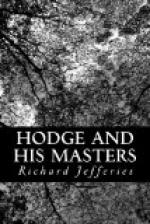It is pleasant, on a sunny day to walk through a field of wheat when the footpath is bordered on either side by the ripening crop, without the intervention of hedge or fence. Such a footpath, narrow, but well kept, leads from a certain country churchyard to the highway road, and passes on the way a wicket gate in a thick evergreen shrubbery which surrounds the vicarage lawn and gardens. This afternoon the wheat stands still and upright, without a motion, in the burning sunshine, for the sun, though he has sloped a little from his highest meridian altitude, pours an even fiercer beam than at the exact hour of noon. The shadeless field is exposed to the full glare of the brilliant light. There are no trees in the field itself, the hedges are cut low and trimmed to the smallest proportions, and are devoid of timber; and, as the ground is high and close to the hills, all the trees in sight are beneath, and can be overlooked. Whether in sunshine or storm there is no shelter—no medium; the wind rushes over with its utmost fury, or the heat rests on it undisturbed by the faintest current. Yet, sultry as it is, the footpath is a pleasant one to follow.
The wheat ears, all but ripe—to the ordinary eye they are ripe, but the farmer is not quite satisfied—rise to the waist or higher, and tempt the hand to pluck them. Butterflies flutter over the surface, now descending to some flower hidden beneath, now resuming their joyous journey. There is a rich ripe feeling in the very atmosphere, the earth is yielding her wealth, and a delicate aroma rises from her generous gifts. Far as the eye can see, the rolling plains and slopes present various tints of yellow—wheat in different stages of ripeness, or of different kinds; oats and barley—till the hedges and woods of the vale conceal the farther landscape on the one hand and the ridge of the hills upon the other.
Nothing conveys so strong an impression of substantial wealth as the view of wheat-fields. A diamond ornament in a window may be ticketed as worth so many hundreds of pounds; but the glittering gem, and the sum it represents, seem rather abstract than real. But the wheat, the golden wheat, is a great fact that seizes hold of the mind; the idea comes of itself that it represents solid wealth.
The tiles of the vicarage roof—all of the house visible above the shrubbery—look so hot and dry in the glaring sunshine that it does not seem possible for vegetation to exist upon them; yet they are tinted with lichen. The shrubbery has an inviting coolness about it—the thick evergreens, the hollies on which the berries are now green, the cedars and ornamental trees planted so close together that the passer-by cannot see through, must surely afford a grateful shade—a contrast with the heat of the wheat-field and the dust of the highway below. Just without the wicket gate a goat standing upon his hind legs, his fore legs placed against the palings, is industriously nibbling the tenderest leaves of the shrubs and trees which he can reach. Thus extended to his full length he can reach considerably higher than might be supposed, and is capable of much destruction. Doubtless he has got out of bounds.




